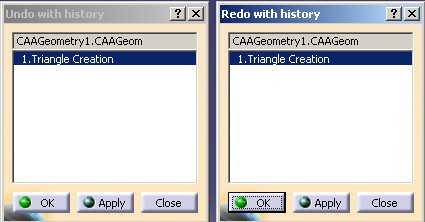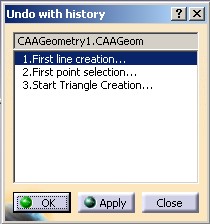3D PLM Enterprise Architecture
|
User Interface - Commands
|
Assigning Resources to a State Dialog Command
How to refer to external resources for the command prompts |
| Technical Article |
Abstract
The resources that you can assign to a state dialog command are the
prompts displayed in the status bar for each proposed interaction as a
help for the end user, and the prompts for each Undo and Redo step to inform the end user of what can be undone or redone.
|
Internationalization and Localization
Even if your don't know if your client application will be used abroad and by
people of a different culture and speaking a language different from yours, it
is always easier, safer, and cheaper to design and code it as if it should be.
Internationalizing a client application means that no assumptions are made about
the language, and more generally the locale, used to run your application when
you design and code it. When such an application is presented in front of end
users from different countries, the same look and feel, and the same functions,
are expected whatever the language and locale used. The localized versions of
the application should then behave as the version in the original language.
Internationalizing an application is also called National Language enabling.
This means that the application should be designed and coded in such a way that
it could be afterwards localized. Localizing means translating the user
interface into the target languages, and possibly do some additional
customization. The key point is that localization never requires to recompile
any part of the application. To enable for that, any character string displayed
in front of the end user must be located in a external text file.
CAA V5 is natively National Language enabled, that is includes all the
necessary stuff for internationalization, and provides you with any tools and
mechanisms to facilitate you internationalizing job.
[Top]
Internationalizing Prompts of State Dialog Commands
You can put the following prompts in a resource file: state prompts and
undo/redo prompts. This section first describes them and next explains how to
assign them to the state dialog objects.
Prompt
Description
- The state prompt
The state prompt is displayed:
- The undo/redo prompts
The undo/redo prompts are related to either a command, an agent or a
transition:
- The command undo prompt is displayed when the command is completed,
and the redo prompt is displayed when it's just undone.
- The agent undo prompt is displayed when the agent input is completed,
and the redo prompt is displayed when the agent input is just undone.
However these two prompts are mandatory only if the agent has the CATDlgEngWithUndoStep
behavior. For the two other behaviors (CATDlgEngWithUndo
and CATDlgEngWithoutUndo) they are useless [2].
- The transition undo prompt is displayed when the transition is
completed, and the redo prompt is displayed when it's just undone.
The undo/redo prompts are visible at several places in an interactive session. Here is an
example with the CAADegCreateTriangleCmd command [1].
- In Edit menu, in place of the Undo/Redo command Titles
- In toolbars, when you pass over the Undo/Redo icons:
- Inside "Undo with history"/ "Redo with history"
dialog boxes.
 These
dialog boxes are undefined commands which are accessible through the icon
boxes of the Standard toolbar.
These
dialog boxes are undefined commands which are accessible through the icon
boxes of the Standard toolbar.
Resource Filename Declaration
The resource filenam for a dialog command should be declared using the CmdDeclareResource
or CmdDeclareResourceFile macro in the dialog command class header
file. The suffix of this file is CATNls. (The CATRsc file is usually not
necessary for a dialog state command)
This macro has two arguments: the dialog command class name is the first parameter, and its base class
is the second one.
class ClassName: public BaseClassName
{
CmdDeclareResource (ClassName,BaseClassName);
public :
}
|
This means that the ClassName class can use the resources defined for the
BaseClassName class, if any, according to the rules explained in Understanding
Resource Inheritance and Concatenation [3].
The resource file name is ClassName.CATNls. Each line of this
file begins by the command class name :
-
CmdDeclareResourceFile
In addition to the CmdDeclareResource capabilities, the CmdDeclareResourceFile
macro enables you to set a resource file name different from the command class name. The first
parameter of this macro is the prefix of the resource file, the dialog command class name is the
second one, and the command base class
is the last one.
class ClassName: public BaseClassName
{
CmdDeclareResourceFile (Filename,ClassName,BaseClassName);
public :
}
|
This means that the ClassName class can use the resources defined for the
BaseClassName class, if any, according to the rules explained in Understanding
Resource Inheritance and Concatenation [3].
The resource file name is FileName.CATNls. In this resource
file, each line begins with the name of the resource file
followed by the command class name:
FileName.ClassName.xxxxxx = "" ;
|
[Top]
State Prompts
A state prompt is associated with a given state of the state dialog command. The
link between the state and the state prompt is done using the state identifier
declared when creating the state using GetInitialState or AddDialogState.
For example, assume that these two states are defined in the BuildGraph
method of the CAADegCreateTriangleCmd state dialog command:
CATDialogState *stStartState = GetInitialState("stFirstPointId");
...
CATDialogState *stSecondState = AddDialogState("stSecondPointId");
...
|
The parameters stFirstPointId and stSecondPointId of
the methods GetInitialState and AddDialogState are the
identifiers of the states stFirstState and stSecondState
respectively.
The state prompt key used to define the state prompt in the message file is
built using the dialog command class name, the state identifier, and the keyword
Message.
(Filename.)ClassName.StateId.Message = "The prompted message";
|
For example, the prompts associated with these two states in the message file
for CAADegCreateTriangleCmd, that is CAADegCreateTriangleCmd.CATNls, are as follows:
CAADegCreateTriangleCmd.stFirstPointId.Message = "Select the first point";
CAADegCreateTriangleCmd.stSecondPointId.Message = "Select the second point";
|
If not any message is assigned to a state, the displayed prompt is the identifier
of the state.
[Top]
Undo/Redo Prompts
Undo/redo is managed at both the command level and inside the command. At the
command level, undo or redo applies to what you did with the command until the
command completed. Inside the command, undo or redo applies to the last
acquisition managed by a dialog agent, or to the last transition.
[Top]
Command Undo/Redo Prompts
The prompt keys are built in the message file using the dialog command class
name and the keywords UndoTitle and RedoTitle
respectively.
(Filename.)ClassName.UndoTitle="The undo message";
(Filename.)ClassName.RedoTitle="The redo message";
|
The undo message should not contain the "Undo" word and the redo
message should not contain the "Redo" word. These two words are
automatically added. It is the reason why the redo prompt can be useless. If the
redo prompt is not specified the undo prompt is used.
For example, the undo prompt associated with the CAADegCreateTriangleCmd command
in the CAADegCreateTriangleCmd.CATNls file is as follows:
CAADegCreateTriangleCmd.UndoTitle="Triangle Creation";
|
The following picture shows the undo and the redo prompts for the
Triangle command :
[Top]
Agent Undo/Redo Prompts
For example, assume that the following dialog agent is created in the BuildGraph
method of the CAADegCreateTriangleCmd dialog command:
...
_daPathElement = new CATPathElementAgent("SelStartPoint");
...
|
The parameter SelStartPoint of the dialog agent constructor is the
dialog agent identifier.
The prompt keys are built in the message file using the dialog command class
name, the dialog agent identifier passed as an argument of its constructor, and
the keywords UndoTitle and RedoTitle respectively.
(Filename.)ClassName.AgentId.UndoTitle="The undo message";
(Filename.)ClassName.AgentId.RedoTitle="The redo message";
|
The undo message should not contain the "Undo" word and the redo
message should not contain the "Redo" word. These two words are
automatically added. It is the reason why the redo prompt can be useless. If the
redo prompt is not specified the undo prompt is used.
For example, the undo prompt associated with the _daPathElement
agent in the CAADegCreateTriangleCmd.CATNls file is as follows:
CAADegCreateTriangleCmd.SelStartPoint.UndoTitle = "First point selection";
|
The following pictures show the undo and the redo prompts for the _daPathElement
agent:
Transition Undo/Redo Prompts
For example, assume that the following transition is created in the BuildGraph
method of the CAADegCreateTriangleCmd dialog command:
...
CATDialogTransition *pSecondTransition = AddTransition
(
stSecondState,
stEndState,
AndCondition(IsOutputSetCondition(_daPathElement),
Condition((ConditionMethod) & CAADegCreateTriangleCmd::CheckPoint2)),
Action((ActionMethod) & CAADegCreateTriangleCmd::CreateLine,
(ActionMethod) & CAADegCreateTriangleCmd::UndoCreateLine,
(ActionMethod) & CAADegCreateTriangleCmd::RedoCreateLine)
) ;
pSecondTransition->SetResourceID("SecondTransition");
...
|
In this case, you need to use the SetResourceID method to set the transition
identifier.
The prompt keys are built in the message file using the dialog command class
name, the transition identifier, and the keywords UndoTitle and RedoTitle
respectively.
(Filename.)ClassName.TransitionId.UndoTitle="The undo transition message";
(Filename.)ClassName.TransitionId.RedoTitle="The redo transition message";
|
The undo message should not contain the "Undo" word and the redo
message should not contain the "Redo" word. These two words are
automatically added. It is the reason why the redo prompt can be useless. If the
redo prompt is not specified the undo prompt is used.
For example, the undo prompt associated with the pSecondTransition
transition in the CAADegCreateTriangleCmd.CATNls
file is as follows:
CAADegCreateTriangleCmd.SecondTransition.UndoTitle = "First line creation";
|
The following pictures show the undo and the redo prompts for the
first transition of the Triangle command:
 If a transition is
triggered when a dialog agent is valued, and if both the
dialog agent and the transition have prompts, only the transition prompt is
displayed.
If a transition is
triggered when a dialog agent is valued, and if both the
dialog agent and the transition have prompts, only the transition prompt is
displayed.
Recommendations
The left
image shows the default title, whereas the right image shows the title coming
from the NLS resource file:
[Top]
In Short
The following keywords should be used to build the keys associated with the
prompts:
| Message |
Prompt associated with a given state. It should be
concatenated with the command and the state identifiers, as follows: (FileName.)ClassName.StateId.Message |
| UndoTitle |
Prompt to describe what the undo does. Applies to commands, agents,
and transitions, and is built using their identifiers.
| Command |
(FileName.)ClassName.UndoTitle |
| Agent |
(FileName.)ClassName.AgentId.UndoTitle |
| Transition |
(FileName.)ClassName.TransitionId.UndoTitle |
|
| RedoTitle |
Prompt to describe what the redo does. Applies to commands, agents,
and transitions, and is built using their identifiers. This prompt is
mandatory only if you want a specific text for the redo, otherwise the undo prompt is used.
| Command |
(FileName.)ClassName.RedoTitle |
| Agent |
(FileName.)ClassName.AgentId.RedoTitle |
| Transition |
(FileName.)ClassName.TransitionId.RedoTitle |
|
[Top]
References
[Top]
History
| Version: 1 [Jan 2000] |
Document created |
| Version: 2 [Aug 2003] |
Document updated |
| [Top] |
Copyright © 2000, Dassault Systèmes. All rights reserved.



![]() These
dialog boxes are undefined commands which are accessible through the icon
boxes of the Standard toolbar.
These
dialog boxes are undefined commands which are accessible through the icon
boxes of the Standard toolbar.





